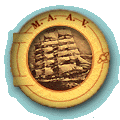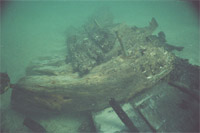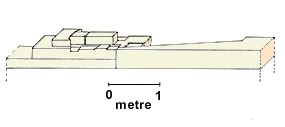|
|
 |
||||||
|
![]() ntroduction:
ntroduction:
Early in April 1988, Melbourne diver George Hamezianos discovered the remains of an old wooden vessel north of Patterson River (Carrum Creek). A short time after, the discovery was reported to the Maritime Archaeological unit (now HSU).
Between May and September 1988, the site was visited on seven occasions by the MAAV with a total of 22.2 hours spent underwater. During this five month period a large amount of sand movement occurred until work had to cease as the sand levels eventually covered ninety percent of the site. Three members of the Maritime Archaeological Association of Victoria carried out a detailed survey of the visible remains: Wayne Caldow, Eric Langenberg and Cate Venturoni with the assistance of George Hamezianos, Kieran Hosty (MAU) and Alan Blackstock (MAAV).

|
Site Description:
During the period of the survey the seaward end of the vessel remained to a large degree buried under a sandbank, however an estimated 60 feet of the hull section was exposed. It has not yet been determined whether the exposed end is the bow or stern.

|
The wreck has a 10 to 15-degree list to shore. The shore side is buried but protrudes at an approximate 60-degree angle from the sand. The most noticeable feature of the wreck is that it appears to be heavily framed. During the survey, 50 frames were exposed on the seaward side. The frames measure 11" x 9" with a 3 inch gap between each. Every alternate frame could in fact be a floor. The rider keelson measures 14" x 14" as does the keelson. The outer planking is 3 inches thick and the ceiling planking where it exists is approximately 4 inches thick. The outer planking is treenail fastened and the ceiling plank is fastened with copper alloy drift bolts. Where one plank is fastened to the stem or sternpost it is edge fastened in iron. There are the remains of yellow metal sheathing on the seaward side of the wreck and lead draft marks on the bow or stern end.
A wooden structure, possibly a structural support for a derrick or similar is located amidships and is partially incorporated into the rider keelson.
See Diagram 1. below.
This structure appears quite complicated incorporating a circular cutout in its design. The structures close proximity to the rider keelsons scarph joint would appear less than ideal in terms of maintaining the structural integrity of the rider keelson. This arrangement suggests that the structure is not part of the vessels original layout but rather a post addition, possibly when and if the vessel underwent conversion to a lighter for instance.
If the true length of the of the vessel is indicated by the current location of the stem and stern ends of the remaining structure then this structure is positioned too far amidships to be considered as a mast step for a two masted vessel such as a brig. This is irrespective of which end of the remains are identified as the stem or stern.
(Note: The Restless was a Brig (two masts) which no doubt underwent some structural changes during its lifetime as it sustained fire damage at one point and in its latter years was converted to a lighter.)
The wreck has acted as a collection point for bottles over the years and there is a predominance of hand blown champagne type bottles. Whether these bottles have any association with the wreck is unknown.

|
Site Plan:
The method employed during the survey was two-point triangulation from a fixed baseline running the length of the rider keelson.
Timber Samples:
Initial observations of the timber on the site suggested that a large proportion was softwood, indicating that the vessel could be of foreign construction, possibly of North American or Canadian origin.
A number of timber samples were taken from th site and identified by Jugo Ilic (CSIRO - Wood Science and Technology) confirming the majority of the timber was indeed North American or Canadian softwoods.
|
Spruce Spruce Birch Oregana Douglas Fir |
Identification:
Communications with a local net fisherman at the time of the survey has revealed that he had known the site as an 'underwater snag' for, some 65 years, predating the wreck to at least 1923. The remains have not been known as a shipwreck in living memory. The MAU have carried out a computer search of their Shipwreck Register but are unable to find any likely candidates at this time. It is quite possible the vessel was hulked but there is no evidence to date to confirm this. The recent discovery of a black and white photograph in the 1905 Australian Sketcher titled 'Wreckage on on Carrum Beach - Mr. A Lucas' is our best clue to date. The image shows the broken bow section of a wooden vessel exposed on the beach.
Finally identified! In November 2000, Peter Taylor with the assistance of Bob Leek and his vast nautical archives discovered the identity of the the Carrum Unknown wrecksite.
Data collected so far suggest fairly conclusively that the remains are of the wooden Brigantine , Restless, built in Novia Scotia in 1866 and was wrecked at its current location in 1902.
See Restless details and period newspaper articles concerning the loss of the Restless.
![]()
Need help with the terminology?